Pearls of wisdom: A retailer’s guide to buying pearls
by charlene_voisin | May 1, 2014 9:00 am
By Massimo Marocco and Manuel Martin
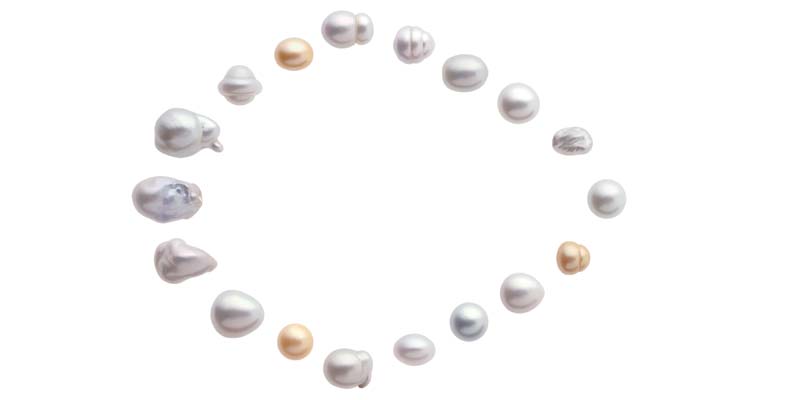 [1]
[1]
Legend has it that pearls were formed from drops of moisture falling from the heavens and swallowed by oysters. Today, we all know the origin of these gems of the sea is not quite so mythical, although they are still considered something of a miracle.
Pearl jewellery has come a long way over the last few years, particularly in the way designers are using this gem. Forget your grandmother’s strand of pearls. These days, designs are sexy, sassy, and a staple in the jewellery wardrobe of today’s hipsters. Even the gents want in on the pearl action.
As we head into the buying season, perhaps it’s time to visit—or revisit—the prospect of adding more pearl jewellery to your store’s selection. Some of you may be thinking that pearls have not been a strong category among your clients—you’ve offered pearl jewellery before, but maybe it wasn’t the hot seller you thought it would be.
Fair enough, but consider the following:
- Have you looked at your pearl selection lately? Is it just a bunch of strands, studs, and some rings?
- Does pearl jewellery occupy a prominent place in your store? Or is it relegated to the back case or back wall?
- Do your sales associates only bring a customer to the case when he or she asks to see your pearl selection?
One of the biggest obstacles to selling pearls is actually knowing the different varieties and what distinguishes a good pearl from a bad one. While this article is not meant to make you a pearl expert overnight, it does offer some guidance that will hopefully make pearl jewellery a stronger category in your store.
Planting a seed
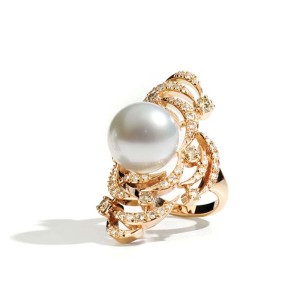 [2]
[2]It’s no wonder the pearl was one of the first gems to be prized. Fresh out of the shell, these wonders could be worn and admired without any of the polishing and fashioning required by other stones. How they are formed is also quite different from other gems.
A pearl is the result of a mollusk’s self-defence mechanism—its response to an irritant. The intrusion can be something like a parasitic worm that has found its way inside, or it can be purposely introduced into the mollusk’s body by human hands. When created as a result of a natural intrusion, the pearl is referred to as ‘natural’; however, when a human contributes to its formation by implanting an irritant, it’s called a ‘cultured’ pearl.
The process is the same for either a natural or cultured pearl. To protect itself, the mollusk forms a sac around any invader that gets inside its body. This sac secretes nacre to cover the irritant. The nacre and sac materials are made by the mollusk’s mantle, the layer of tissue surrounding its body and lining the shell. The mantle tissue cells that make up the pearl sac are called epithelial cells.
A cultured pearl is created via two methods: bead nucleation and tissue nucleation. Bead nucleation is the method used for saltwater oysters. Here, nucleators surgically implant a bead nucleus and a small piece of mantle tissue in or near the animal’s gonad, or reproductive organ. Bead nuclei are typically made from freshwater mussel shells found in North America, while mantle tissue comes from a donor mollusk.
Tissue nucleation is used for the majority of freshwater mussels. This process requires a nucleator implant a piece of mantle tissue into a mussel, rather than a bead. Another difference is that the nucleator places the tissue in the wide, fleshy mantle area, instead of the gonad.
When nucleation is successful, the mussel deposits layers of nacre around the mantle tissue, forming a cultured pearl. Since there is no bead nucleus, a tissue-nucleated cultured pearl is almost entirely composed of nacre.
The majority of pearls today are of the cultured variety. While there are still some natural pearls being harvested in the Middle East, the quantities are very small and their shapes irregular.
Valuation criteria for a pearl
There are many assessment techniques and criteria used to value a cultured pearl, but what they must all take into account is that beauty equals quality—the more beautiful the pearl, the higher its quality. There are four basic factors that define a pearl’s quality: lustre, surface, shape, and colour.
Lustre
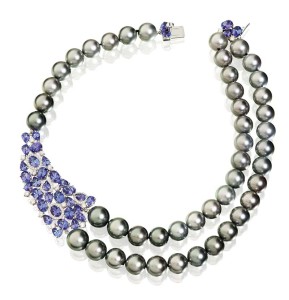 [3]
[3]Lustre describes the level of intensity and beauty of the light reflected by the pearl and refracted by the nacre layer. For excellent lustre, a pearl must be formed by a thick layer of high-quality nacre. Nacre is the pearly substance made of organic and inorganic materials secreted by a particular tissue in the mollusk.
A pearl consists of hundreds of layers of nacre covering the nucleus. Each layer is composed of thousands of ‘microscopic tiles’ overlapping in a surprisingly uniform arrangement. The infinite possible compositions of the nacre tiles lead to considerable differences in appearance between pearls and the elusive beauty of a gem’s inner glow or its ‘orient,’ which is an iridescent effect. The more perfect the composition of the tiles and their arrangement, the more exceptional the reflections produced by the nacre.
Lustre is the most important of the four factors used to determine a pearl’s quality, and by extension, its value. The price of a pearl depends on its grade of lustre, which is described using the following scale:
A”“Excellent: Very high, almost metallic lustre, produced by a thick, high-quality nacre with excellent refractive properties.
B”“Good: High, non-metallic lustre—which is evidence of a thick layer of nacre—although with lesser refractive properties.
C”“Fair: Thinner, lower-quality nacre than the first two grades, with less refractive brilliance. As a result, lustre is a little more opaque.
D”“Poor: Possesses a layer of poor-quality nacre that does not refract light to any satisfactory degree. Pearls of this grade are not generally sold.
Surface
A pearl’s surface is the second most important factor influencing its value. Like emeralds, most pearls possess various birthmarks. Surface appearance is generally classified according to the following grades:
1″“No visible blemish: Such pearls are used for the highest class of jewellery or on strands of extraordinary beauty and quality.
2″“Small blemishes: The pearl exhibits slight imperfections.
3″“Numerous blemishes: The surface displays many imperfections or deep blemishes, though if the pearl has high lustre, it is ideal for medium-quality jewels, original pieces with emphasis on design, or reasonably priced strings.
4″“Very obvious blemishes: The entire surface of the pearl shows imperfections, deep blemishes, and marks.
Shape
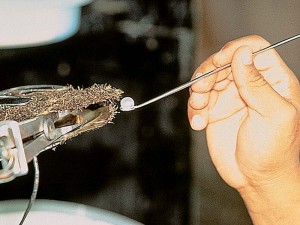 [4]
[4]The rarest and most sought-after pearls are perfectly round or with a pronounced drop shape. For convenience, shape is categorized by the following descriptors:
- round;
- oval;
- drop;
- button;
- near-round;
- baroque;
- semi-baroque; and
- circled.
Â
Colour
Since light is refracted through the nacre’s prismatic calcium crystals, pearls can display almost all the colours of the rainbow. A pearl’s colour does not affect its quality, but influences perceptions of its beauty according to personal taste. Most pearls are white, light grey, or cream, but some may even have pink, green, or yellow tones. Gold, cognac, peach, green, and champagne pearls do occur naturally, but this is very rare.
Some colours have become more popular in particular markets. For instance, white is very much in demand in the United States, while silver-grey is big in Asia and creamy pink in France. Strong demand for certain colours can drive up a pearl’s price.
Freshwater cultured pearls
 [5]
[5]Freshwater pearls are cultured in mussels called Hyriopsis cumingi (i.e. triangle shell). These pearls are generally very inexpensive, since one mussel can produce as many as 50 at a time and they generally take less than a year to grow. The term ‘Chinese pearl’ often has a negative connotation, since this variety can be extremely inexpensive and of lesser quality. However, Chinese pearls with better shape and lustre are also appearing on the market. Freshwater pearls are generally valued according to the same criteria as other cultured pearls. Here are some of the qualities to consider when buying freshwater pearls.
Shape
A pearl’s value is determined by how round it is, although most freshwater pearls are irregular in shape (also known as baroque). The rounder shapes are priced higher than oval or flat.
Smoothness
Smooth freshwater pearls are more valuable than those with bumpy or wrinkled surfaces.
Colour
Freshwater pearls come in a wide variety of colours: white, pink, orange, yellow, lavender, grey, or bronze. For this reason, 90 per cent of white freshwater pearls sold today are bleached. On the other end of the scale, a great number are also dyed.
Nacre thickness
Nacre thickness is an important factor in both freshwater and saltwater pearls. Often, nacre thickness is very high in freshwater pearls, as they do not have a nucleus. However, the quality of this nacre is much lower than of a saltwater pearl’s and, consequently, so is the price.
Saltwater cultured pearls
There are basically three different types of saltwater cultured pearls: Akoya, Tahitian, and South Sea.
- Beginning in the 1900s, Akoya pearls were the first variety to be cultivated in Japan. Usually created using Pinctada fucata oysters, most Akoya cultured pearls are white or cream, with some exhibiting hints of pink or green. The Akoya oyster is relatively small, so it does not usually produce a cultured pearl larger than 9 mm. Akoyas are considered a step above freshwater pearls in quality.
- Tahitian pearls have only been on the market since the 1970s. The black-lipped oyster—Pinctada margaritifera—produces Tahitian pearls in colours like eggplant purple, peacock green, and a wide variety of greys, including nearly black and greyish blue. The black-lipped oyster is native to French Polynesia and is also farmed in the nearby Cook Islands. It can grow as large as 30 cm (12 in.) in diameter, sometimes weighing 5 kg (11 lbs), and produce pearls from 9 mm to 20 mm.
- South Sea pearls are grown in the warm waters of Australia, the Philippines, Indonesia, Myanmar (formerly known as Burma), and Thailand. These areas are the natural habitat of the huge oyster, Pinctada maxima, which occurs in two varieties: the silver lip and gold lip. They can be identified by the colour of the shell’s external lip.
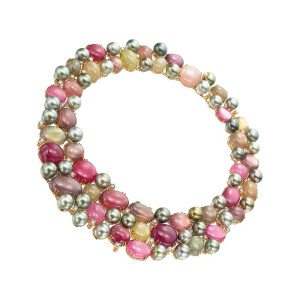 [6]
[6]South Sea pearls are the largest pearls in the market and have the thickest nacre of all varieties, making them more resilient to wear. Although they keep their lustre for years on end, they are also more difficult and more costly to produce. This is due to their longer gestation period—usually two years—and the constant monitoring of water quality required to grow them. This combination of factors makes South Sea pearls the rarest and most precious of all.
In general, silver-lip Pinctada Maxima creates pearls that are white, silver, and slightly pinkish in colour, while the gold-lip kind produces pearls in a variety of yellow and golden hues. Both silver lip and gold lip produce pearls in the 9- to 20-mm range, with 13 mm being the average size.
The size of a pearl is determined by the oyster’s ability to secrete nacre. Generally speaking, Pinctada Maxima produces the best quality of nacre. Thick nacre creates a suffused opalescence, tinted by a kind of metallic brilliance that determines the pearl’s colour. With its wide range of colours, South Sea pearls have become a favourite among jewellery designers. In fact, mixing various colours can create a hipper look that appeals to younger fashionistas. The incredible variety of South Sea pearls is also a great source of inspiration for jewellery designers.
Now that you have a better sense of what to look for when buying pearls, it’s time to push your own boundaries. A dainty strand of pearls is timeless, but today’s designers are broadening the appeal of these gems with edgy and fashion-forward styles perfect for the classy and chic customer. With these, you just may find yourself moving your pearl selection off the back wall.
Massimo Marocco is a pearl buyer and grader, and has served as stone manager of Utopia-Gaia for the last 27 years. He is a graduate of Gemological Institute of America’s (GIA’s) pearl and pearl grading course. He can be reached at massimo.marocco@gaia.it[7]. Manuel Martin is director of U.S. operations for Utopia-Gaia. He can be reached at m.martin@utopia-jewels.com[8].
- [Image]: http://www.jewellerybusiness.com/wp-content/uploads/2015/11/several-type-of-pearls-diagram.1-.jpg
- [Image]: http://www.jewellerybusiness.com/wp-content/uploads/2015/11/YCA1RH.jpg
- [Image]: http://www.jewellerybusiness.com/wp-content/uploads/2015/11/PRTP766-GGA63.jpg
- [Image]: http://www.jewellerybusiness.com/wp-content/uploads/2015/11/10.jpg
- [Image]: http://www.jewellerybusiness.com/wp-content/uploads/2015/11/11.jpg
- [Image]: http://www.jewellerybusiness.com/wp-content/uploads/2015/11/UTOPIA_GGA60.jpg
- massimo.marocco@gaia.it: mailto:massimo.marocco@gaia.it
- m.martin@utopia-jewels.com: mailto:m.martin@utopia-jewels.com
Source URL: https://www.jewellerybusiness.com/features/pearls-of-wisdom-a-retailers-guide-to-buying-pearls/